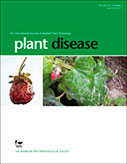Ver ítem
- xmlui.general.dspace_homeCentros e Institutos de InvestigaciónCICVyA. Centro de Investigación en Ciencias Veterinarias y AgronómicasInstituto de GenéticaArtículos científicosxmlui.ArtifactBrowser.ItemViewer.trail
- Inicio
- Centros e Institutos de Investigación
- CICVyA. Centro de Investigación en Ciencias Veterinarias y Agronómicas
- Instituto de Genética
- Artículos científicos
- Ver ítem
Virulence characterization and identification of maize lines resistant to Puccinia sorghi Schwein. Present in the argentine corn belt region
Resumen
Puccinia sorghi Schwein., the causal agent of maize common rust, is an endemic disease in the Argentine Corn Belt region. Virulence surveys of the pathogen population within the region have not been performed; thus, the understanding of the pathogen population is low and it is difficult to deploy resistance genes that could be effective at controlling the disease. In total, 58 single-uredinial isolates derived from infected maize leaves collected in
[ver mas...]
Puccinia sorghi Schwein., the causal agent of maize common rust, is an endemic disease in the Argentine Corn Belt region. Virulence surveys of the pathogen population within the region have not been performed; thus, the understanding of the pathogen population is low and it is difficult to deploy resistance genes that could be effective at controlling the disease. In total, 58 single-uredinial isolates derived from infected maize leaves collected in different locations throughout the Argentine Corn Belt region during 2010 to 2012 were tested on a set of 25 maize lines carrying different Rp genes. Maize lines Rp3-A and PIO19802 showed the lowest virulence frequencies (3.4 and 1.7%, respectively) for all tested isolates. Moreover, the combination in a single genotype of the resistance genes carried by lines Rp3-A and PIO19802 or either of these lines combined with the resistance genes from PIO12345 would confer resistance to all isolates tested. Virulent isolates on maize lines Rp-G, Rp1-K, and Rp-GI were most frequent in 2012. Twenty-four virulence phenotypes were identified, with phenotypes TCCG (17.2%), TTBB (15.5%), and TCFG (10.3%) being the most common throughout the region. Adult plant resistance associated with hypersensitive response was identified at vegetative stage 6 in maize lines PIO68752, PIO28427, and PIO36420.
[Cerrar]

Autor
Darino, Martín Alejandro;
Rochi, Lucía;
Lia, Veronica Viviana;
Kreff, Enrique D.;
Pergolesi, María Fernanda;
Ingala, Lorena Romina;
Dieguez, Maria Jose;
Sacco, Francisco;
Fuente
Plant disease 100 (4) : 770-776. (2016)
Fecha
2016-04
ISSN
0191-2917
Formato
pdf
Tipo de documento
artículo
Palabras Claves
Derechos de acceso
Abierto
 Excepto donde se diga explicitamente, este item se publica bajo la siguiente descripción: Creative Commons Attribution-NonCommercial-ShareAlike 2.5 Unported (CC BY-NC-SA 2.5)
Excepto donde se diga explicitamente, este item se publica bajo la siguiente descripción: Creative Commons Attribution-NonCommercial-ShareAlike 2.5 Unported (CC BY-NC-SA 2.5)


